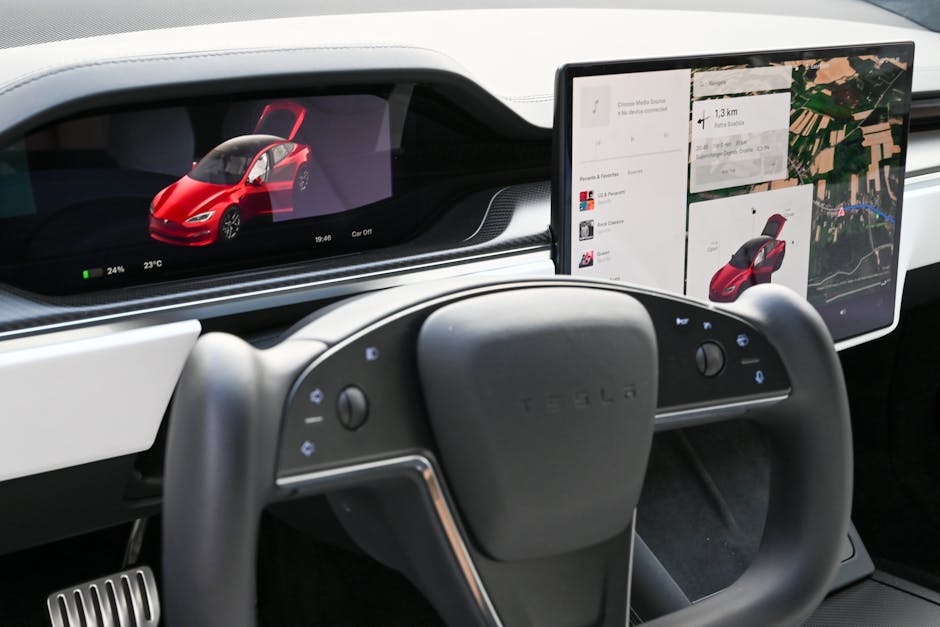Advanced car technology: 7 Powerful Innovations for 2025
The Revolution in Advanced Car Technology
Advanced car technology is changing vehicles from simple transportation into connected, intelligent mobility platforms. Today’s innovations combine safety, connectivity, autonomy, and sustainability in ways that were science fiction just a decade ago.
Here’s what defines modern advanced car technology:
| Technology Category | Key Features | Real-World Benefits |
|---|---|---|
| Safety Systems | ADAS, automatic emergency braking, lane-keeping | 90% of accidents are caused by human error; these systems can prevent or mitigate crashes |
| Connectivity | Infotainment, OTA updates, smartphone integration | 91% of new cars sold in 2020 offered internet connectivity |
| Autonomous Features | Level 2-3 driving assistance, self-parking | Reduces driver fatigue and stress while improving safety |
| Electrification | EVs, hybrids, regenerative braking | The 2024 Ford Maverick hybrid achieves 42 mpg in city driving |
| Biometrics | Face/fingerprint recognition, health monitoring | Personalizes settings and improves security |
“It’s predicted that cars will change more in the next five to 10 years than they have over the past 50,” according to automotive industry experts. This isn’t hyperbole – we’re witnessing a change comparable to the early 20th century shift from horse-drawn carriages to automobiles.
The pace of innovation is breathtaking. Features once exclusive to luxury flagships now appear in affordable models like the 2024 Hyundai Elantra ($21,625), which includes automatic emergency braking, pedestrian detection, and driver attention monitoring as standard equipment.
These technologies aren’t just about convenience – they’re reshaping our relationship with mobility. Advanced driver assistance systems provide a safety net for human error. Electric powertrains deliver instant torque while reducing emissions. Over-the-air updates keep vehicles improving long after purchase. And vehicle-to-everything (V2X) communication prepares cars to talk with infrastructure, pedestrians, and each other.

Advanced Car Technology & Next-Gen Safety Systems
The most immediate impact of advanced car technology comes from safety systems that actively work to prevent accidents. Advanced Driver Assistance Systems (ADAS) represent a fundamental shift from passive safety (like airbags that deploy during a crash) to active safety that helps avoid collisions altogether.
“Typically, these systems do an even better job than good drivers,” says Greg Brannon, an automotive safety expert quoted in our research. This isn’t just marketing hype – it’s backed by data showing that vehicles equipped with automatic emergency braking experience fewer rear-end collisions.
Modern ADAS features have transformed how we drive. Automatic emergency braking detects obstacles and applies brakes to prevent crashes. Lane-keeping assistance uses cameras to detect lane markings and gently steers you back if you drift. Pedestrian and cyclist detection identifies vulnerable road users and warns you or automatically brakes. And night vision systems, like those in the 2024 Jeep Grand Cherokee, use infrared cameras to spot people and animals beyond your headlights’ reach.
Perhaps most fascinating is Nissan’s Brain-to-Vehicle technology, which detects brainwaves indicating you’re about to steer or brake. The system can initiate that action 0.2-0.5 seconds faster than you physically could – potentially turning a collision into a near-miss.

Smarter Sensors & AI Decision-Making
The magic behind these safety systems comes from an array of sophisticated sensors working together. Cameras provide visual information about lane markings and obstacles. Radar uses radio waves to detect objects and their speed, even in poor visibility. LiDAR creates detailed 3D maps by bouncing laser light off objects. Ultrasonic sensors detect close-range obstacles when you’re parking, while cutting-edge ground-penetrating radar can read unique patterns beneath the road to help vehicles steer when surface landmarks disappear under snow or construction.
What makes today’s systems truly remarkable is how artificial intelligence fuses all this data to make split-second decisions. When a pedestrian steps into the road, the AI instantly detects them, calculates their trajectory, determines collision probability, and decides whether to alert you or automatically brake – all in milliseconds, often more reliably than human reaction times.
But these systems aren’t perfect. Research from AAA warns that pedestrian detection systems often fail in darkness, when 75% of pedestrian fatalities occur. This reminds us that while advanced car technology is impressive, it supplements – rather than replaces – attentive driving.
Advanced Car Technology for Everyday Drivers
The democratization of safety technology may be the most significant trend in automotive development. Features once reserved for flagship luxury models now come standard in affordable vehicles.
Take the 2024 Hyundai Elantra, starting at just $21,625. It includes automatic emergency braking with pedestrian detection, lane-keeping assist, driver attention monitoring, blind-spot monitoring with collision avoidance, and rear cross-traffic alert with automatic braking.
These aren’t watered-down versions either. The Elantra’s blind-spot view system displays a live camera feed of your blind spot in the instrument panel when you activate your turn signal – technology that debuted in luxury vehicles just a few years ago. Similarly, the 2024 Nissan Versa, starting at just $16,390, includes automatic emergency braking, lane departure warning, and automatic high beams as standard equipment.
This democratization means safer roads for everyone, not just those who can afford premium vehicles. When a family shopping for an affordable compact car gets the same advanced car technology that previously required a luxury budget, we all benefit. The technology that might save your life – or someone else’s – is becoming as standard as seatbelts once were.
Always-Connected Cabins & Over-the-Air Upgrades
Remember when cars were just… cars? Now they’re rolling smartphones on wheels. In 2020, a whopping 91% of all new cars sold came with internet connectivity, changing our vehicles from simple transportation into digital hubs that keep us connected wherever we go.
Modern infotainment systems have come a long way from the clunky interfaces of yesterday. They now neatly combine entertainment, navigation, climate controls, and vehicle settings in sleek touchscreen displays. Take the 2024 Hyundai Santa Fe—it comes standard with wireless Android Auto and Apple CarPlay, letting you seamlessly integrate your digital life with your driving experience. No cables required!
But the real game-changer in advanced car technology isn’t what you see on the dashboard—it’s what happens behind the scenes. Over-the-air (OTA) software updates have revolutionized how we think about car ownership. Tesla might have pioneered this approach, but now almost every manufacturer offers some form of wireless updating capability.

“We’ve come to expect much more from a car than simply transporting us from point A to point B,” notes an automotive connectivity expert. And they’re right—today’s vehicles function more like digital platforms that actually improve over time through software updates. This marks a fundamental shift from the traditional model where cars only depreciate after purchase. Your car can actually get better with age!
Infotainment That Learns You
The latest infotainment systems don’t just respond to commands—they learn your preferences and adapt to your habits. Voice assistants have evolved from rigid command structures to natural conversation partners. Just speak normally, and your car understands what you need.
Gesture controls are another intuitive feature making waves. BMW’s system lets you answer calls or adjust volume with a simple hand movement—no need to take your eyes off the road to find a button or screen. Wave goodbye to distracted driving!
Perhaps most impressive are the personalized profiles that remember everything from your preferred seat position to your favorite radio stations. The Mercedes-Benz User Experience (MBUX) exemplifies this personalization with its “Hey Mercedes” voice assistant that actually learns from your interactions. Feeling chilly? Just say “I’m cold” instead of specifying a temperature, and the system raises the cabin heat. It’s like having a thoughtful companion along for every drive.
Behind these seamless experiences are domain controllers—powerful centralized computers that manage multiple screens and functions. These digital brains replace dozens of separate electronic control units, enabling a smooth experience across digital instrument clusters, center displays, passenger screens, and rear entertainment systems.
Advanced Car Technology Keeps Cars Fresh
Remember when buying a car meant accepting that what you drove off the lot was what you’d have forever? Those days are gone. Over-the-air updates now deliver three fantastic benefits that keep your car feeling fresh years after purchase.
First, manufacturers can introduce entirely new features to existing vehicles. Your car literally gains new abilities overnight! Second, performance improvements can improve efficiency, extend range, or sharpen driving dynamics without a single wrench being turned. And third, bug fixes can resolve issues without the hassle of a dealer visit—just like your smartphone updates while you sleep.
Tesla owners have experienced this benefit for years, receiving everything from “Sentry Mode” security features to improved acceleration through simple software updates. Traditional manufacturers are catching up quickly; Ford’s Mustang Mach-E has received performance boosts and new features long after customers took delivery.
This capability transforms the ownership experience in profound ways. As Greg Brannon explains, “The nomenclature is a safety issue.” OTA updates allow manufacturers to standardize and clarify how features work, addressing the confusion caused by different brands using different names for essentially the same technologies.
Want to learn more about how connectivity is reshaping the driving experience? Visit our dedicated page at Carnews4you.com/automotive-connectivity-solutions for a deeper dive into this fascinating world of advanced car technology.
Electrified & Alternative Powertrains Changing the Game
The electric revolution isn’t just coming—it’s already here, changing the automotive landscape through innovative advanced car technology. This shift goes far beyond simply swapping gas tanks for batteries; it’s fundamentally changing how our vehicles move, refuel, and interact with our world.
Today’s electrified vehicles come in several compelling flavors:
Battery Electric Vehicles (BEVs) run purely on electricity stored in their battery packs, offering a driving experience that’s both whisper-quiet and surprisingly powerful. Plug-in Hybrid Electric Vehicles (PHEVs) give you the best of both worlds—electric driving for your daily commute with a gas engine for longer trips. Traditional Hybrid Electric Vehicles (HEVs) use small batteries and motors to boost efficiency without requiring you to plug in. And for those looking even further ahead, Fuel Cell Electric Vehicles (FCEVs) create electricity on-demand using hydrogen, emitting nothing but water vapor.
The performance numbers of today’s electric vehicles would have seemed like science fiction just a few years ago. Take the 2024 Lucid Air Sapphire—it delivers a jaw-dropping 1,234 horsepower and can rocket from 0-60 mph in just 1.89 seconds. Even more impressive, it offers up to 500 miles of range on a single charge. These aren’t concept car numbers; they’re available at dealerships right now.
But the electric revolution brings benefits beyond just speed. The 2024 Ford F-150 Lightning transforms the humble pickup truck into a mobile power station. During a blackout, this truck can actually power your entire home through its vehicle-to-load (V2L) capability. Imagine running your refrigerator, lights, and even air conditioning from your parked vehicle!

Even the way we “refuel” is getting smarter. Wireless charging pads from companies like Continental and WiTricity can now transfer electricity at up to 11 kW—comparable to many home charging stations—without a single cable or plug. Simply park your compatible EV over the pad, and charging begins automatically. It’s the kind of convenience that makes you wonder how we ever lived without it.
Energy Solutions Beyond the Plug
The innovation doesn’t stop with plugs and batteries. Clever engineers are finding all sorts of ways to capture, store, and use energy more efficiently.
Some of the newest EVs now incorporate solar panels right into their bodies, potentially adding up to 44 extra miles of range each day just by sitting in the sunshine. It’s like having a tiny gas station on your roof!
Regenerative braking has become standard on virtually all electrified vehicles, capturing energy that would normally be wasted as heat during braking and feeding it back into the battery. It’s like getting a small refund every time you stop.
For heavy-duty applications, hydraulic-hybrid systems store braking energy as compressed nitrogen, providing powerful assistance when needed without the weight of large batteries.
Even traditional engines are getting smarter. Turbocharging and downsizing allow smaller engines to deliver big-engine power with small-engine efficiency. The 2024 Nissan Rogue showcases this brilliantly with its 1.5-liter variable compression engine that can physically change how it operates based on driving conditions—prioritizing power when you’re accelerating onto the highway and switching to efficiency when cruising.
What’s particularly interesting is what’s driving people to choose electric vehicles. Research from the Consumer Technology Association reveals that early adopters often cite performance advantages as their primary motivation. The instant torque and smooth acceleration of electric motors create a driving experience that many find genuinely superior to conventional engines. It turns out going green can also mean going fast!
Comparing Electric Powertrain Options
| Powertrain Type | Range | Charging/Refueling Time | Key Advantage | Example Model |
|---|---|---|---|---|
| Battery Electric | 200-500+ miles | 20-60 minutes (fast charge) | Zero emissions, lowest operating cost | 2024 Rivian R1T: 835 hp, 400+ mile range |
| Plug-in Hybrid | 20-40 miles electric + gas range | 2-5 hours (Level 2) for battery | Flexibility, no range anxiety | 2024 Chrysler Pacifica Hybrid: 32 miles electric range |
| Conventional Hybrid | Gas range with improved MPG | Regular gas fill-up | No plugging in, improved efficiency | 2024 Toyota Sienna: 36 mpg combined |
| Hydrogen Fuel Cell | 300-400 miles | 5 minutes | Quick refueling, water-only emissions | Toyota Mirai: 402-mile range |
The electrification revolution isn’t slowing down. According to research on EV adoption, the market is expanding beyond early adopters into the mainstream, with more affordable options appearing every year. As charging infrastructure continues to expand and battery technology improves, the question for most drivers is shifting from “if” they’ll go electric to “when.”
Autonomous & Semi-Autonomous Driving Levels
When people talk about self-driving cars, they’re really discussing a spectrum of capabilities. The journey to fully autonomous vehicles unfolds across six distinct levels:
- Level 0: Your grandpa’s car—100% human-controlled with zero automation
- Level 1: Think adaptive cruise control that handles one task while you manage everything else
- Level 2: The car handles steering and speed simultaneously (like Tesla Autopilot’s basic functionality)
- Level 2+: More sophisticated partial automation with advanced features
- Level 3: The car drives itself in certain conditions but might ask you to take over
- Level 4: Nearly self-sufficient driving that rarely needs human intervention
- Level 5: The holy grail—full automation with no human input needed, ever
Most cars on the road today hover around Level 1 or 2. Mercedes-Benz Drive Pilot represents one of the first commercially available Level 3 systems in Germany, allowing drivers to actually take their attention off the road in specific conditions like heavy traffic under 40 mph.

Level 2+ systems are where much of the excitement lives today. GM’s Super Cruise lets you drive hands-free on over 400,000 miles of mapped highways while its eye-tracking camera makes sure you’re watching the road. Ford’s BlueCruise works similarly, and Tesla’s Autopilot with Full Self-Driving Capability adds features like automatic lane changes and navigation-based driving.
The naming of these systems creates real confusion, though. As automotive safety expert Greg Brannon puts it, “We can’t control the marketers, but the nomenclature is a safety issue.” Many drivers mistakenly believe their car can drive itself completely when they hear terms like “Autopilot” or “Full Self-Driving”—a potentially dangerous misunderstanding.
Want to explore the cutting-edge autonomy features in today’s luxury vehicles? Check out our detailed coverage at Carnews4you.com/luxury-car-technology.
Brain-to-Vehicle Interfaces Push Boundaries
Imagine your car responding to your thoughts before your hands even move the wheel. That’s the promise of Nissan’s Brain-to-Vehicle (B2V) technology—perhaps the most sci-fi advanced car technology currently in development.
This system uses an EEG skullcap (think a high-tech swimming cap with sensors) to monitor brain activity patterns related to driving decisions. When your brain decides to steer or brake, it produces “movement-related cortical potentials” that the system can detect 0.2-0.5 seconds before your muscles actually respond. In that brief moment, the car can begin the action for you—potentially making the difference between a close call and a collision.
The technology doesn’t stop there. It also recognizes when the vehicle behaves differently than you expected by detecting “error-related potentials” in your brain. This allows the system to learn your driving preferences and adjust its autonomous behavior to match your style.
During testing, Nissan finded something even more fascinating: drivers receiving electrical brain stimulation during training learned new driving courses 50% faster than those without stimulation. This hints at applications beyond safety that could improve performance driving or help novice drivers master skills more quickly.
Advanced Car Technology Still Needs Humans
Despite the impressive progress, we’re still a long way from kicking back and napping while our cars handle the commute. Fully autonomous vehicles face substantial problems:
The regulatory landscape remains a patchwork of different rules across countries and even between states. Liability questions loom large—who’s responsible when a self-driving car crashes?
Then there are the “edge cases”—those unusual driving scenarios that confound AI decision-making. A construction worker waving cars through a detour. A plastic bag blowing across the road. A deer darting from the woods. Human drivers instantly recognize and respond to these situations, but they’re extraordinarily difficult to program into an algorithm.
Weather continues to be a major limitation. Heavy rain can obscure camera lenses, snow can cover lane markings, and fog can reduce the effectiveness of LiDAR and other sensors. Most autonomy systems simply disable themselves in poor conditions—precisely when human drivers would benefit most from assistance.
The ethical questions get thorny too. How should a car be programmed to respond in an unavoidable crash? Should it prioritize its occupants or minimize total harm? These aren’t just technical problems but profound moral dilemmas.
Europe’s safety testing organization, Euro NCAP, has established a roadmap requiring autonomous systems to clearly communicate their capabilities and limitations. Starting in 2026, vehicles must include physical buttons for key functions to receive a 5-star safety rating—a recognition that touchscreen-only interfaces can distract drivers at critical moments.
As one industry expert explains, “The biggest challenge isn’t building the technology—it’s building trust.” Standardizing terminology around driver assistance systems would help consumers understand what their vehicles can—and cannot—do without supervision. After all, advanced car technology works best when it improves human capabilities rather than trying to replace them entirely.
Vehicle-to-Everything (V2X) & Smart Infrastructure
Imagine a world where your car doesn’t just talk to you—it talks to everything around it. That’s the promise of Vehicle-to-Everything (V2X) communication, perhaps the most exciting frontier in advanced car technology today.
Think of V2X as creating a constant conversation between your vehicle and the world. Your car can chat with other vehicles to warn about sudden braking ahead. It can receive updates from traffic lights about when they’ll turn green. It can even alert pedestrians through their smartphones that you’re approaching an intersection. The possibilities are genuinely transformative.
V2X connections happen across multiple channels:
- When cars talk to other cars (V2V), they can warn about hazards you can’t yet see
- When cars talk to infrastructure (V2I), traffic lights can count down to green
- When cars talk to pedestrians (V2P), people get alerts about approaching vehicles
- When cars talk to networks (V2N), they access real-time traffic and weather data
- When electric cars talk to the power grid (V2G), they can sell excess electricity back
- When cars talk to your home (V2H), they can warm up your house as you approach
The industry is increasingly favoring Cellular Vehicle-to-Everything (C-V2X) technology that uses 5G networks over the older Dedicated Short-Range Communications (DSRC) standard. C-V2X offers greater range and bandwidth—perfect for sharing rich data quickly.

Audi has already rolled out a taste of this future with their traffic light information system in select cities. Drivers see countdown timers for red lights and get speed recommendations to catch “green waves” of synchronized signals. It’s not just convenient—it reduces unnecessary stopping and starting, improving both fuel efficiency and traffic flow.
How V2X Works & Why It Matters
The magic of V2X lies in its speed. These systems operate with ultra-low latency—technical speak for “really, really fast communication.” When the car ahead suddenly slams on its brakes, V2V alerts can reach your vehicle before you even notice their brake lights. In emergency situations, those milliseconds could literally save lives.
But safety is just the beginning of what V2X offers. When vehicles and infrastructure work together, we get smoother traffic flow as cars coordinate their movements to reduce congestion. This means less time sitting in traffic, lower emissions from idling engines, and less stress for everyone.
Advanced car technology like V2X creates a kind of digital teamwork that benefits everyone. Imagine your car automatically reporting that pothole you just hit, so road crews know exactly where repairs are needed. Or picture emergency vehicles broadcasting their approach, allowing traffic signals to create a clear path through busy intersections.
One of the most promising applications is truck platooning, where multiple commercial vehicles travel in a tight, coordinated formation. The lead truck cuts through the air, creating a slipstream that reduces drag for the following trucks—improving fuel economy by up to 10%. V2X communication ensures they maintain safe distances while reacting as a single unit to traffic conditions.
For pedestrians, especially those with visual or hearing impairments, V2X could be life-changing. Using 5G-based C-V2X, vehicles can send warnings directly to smartphones about potential collision risks, creating an invisible safety net for vulnerable road users.
Building the Network Today
While the full V2X dream isn’t quite reality yet, clever approaches are speeding up deployment. Cities are equipping service vehicles like garbage trucks and delivery vans with sensors that continuously update high-definition maps as they follow their regular routes. These vehicles become rolling data collectors, refreshing map information daily instead of waiting for dedicated mapping vehicles.
Some systems use ground-penetrating radar to create maps of subterranean features like pipes and soil density patterns. Unlike surface landmarks that can be obscured by snow or construction, these underground references remain consistent, providing reliable navigation data in all conditions.
Security remains a top concern for V2X implementation—and rightfully so. These systems must protect against both data privacy breaches and potential cyber attacks that could compromise safety. Industry groups are working overtime on encryption standards and authentication protocols to ensure that when your car “talks,” it’s only sharing with trusted partners.
The road to widespread V2X adoption faces challenges in standardization, ensuring vehicles from different manufacturers can communicate seamlessly. But progress continues steadily as automakers, tech companies, and governments recognize the tremendous potential of creating truly connected transportation networks.
As we build toward this connected future, one thing is clear: the cars of tomorrow won’t just be smarter individually—they’ll be working together as part of an intelligent, responsive transportation ecosystem that’s safer, more efficient, and more sustainable for everyone.
Sustainable Materials & Future-Facing Innovations
The green revolution in advanced car technology goes far beyond what powers your vehicle—it’s changing every aspect of how cars are made, what they’re made from, and how long they’ll last.
Today’s forward-thinking automakers are embracing materials that would have seemed experimental just a few years ago. Vegan leather made from cactus fibers and pineapple leaves offers a luxurious feel without animal products. Recycled ocean plastics find new life as dashboard components and door panels. Even the seats beneath you might contain bio-based composites using natural fibers like flax or hemp, paired with resins derived from plant sources rather than petroleum.
Take the upcoming 2025 Hyundai IONIQ 9, which showcases this holistic approach to sustainability. Its interior features fabrics woven from recycled PET bottles, paints derived from vegetable oils instead of harmful chemicals, and wood trim harvested through certified sustainable forestry. What’s remarkable is how these materials don’t feel like compromises—they perform as well as (and sometimes better than) their conventional counterparts.

Super magnesium is particularly exciting—this next-generation alloy weighs less than aluminum while offering strength comparable to steel, with a significantly lower environmental footprint during production. When used in structural components, it helps vehicles shed weight without sacrificing safety.
The way cars are built is changing too. 3D printing has moved beyond prototyping into actual production parts, allowing for incredibly complex, lightweight components that would be impossible to manufacture through traditional methods. This technology opens the door to truly personalized vehicles, where body panels and interior elements could be printed to individual specifications on standardized platforms. Imagine ordering replacement parts that print locally rather than shipping across the globe!
In an interesting twist, physical buttons are making a comeback in vehicle interfaces. After years of touchscreen-dominated dashboards, automakers are refinding the value of tactile controls you can operate without looking. This isn’t just nostalgia—Euro NCAP’s upcoming safety standards will require physical buttons for key functions starting in 2026 to earn a 5-star rating. Sometimes, the old ways really are better for certain applications.
Want to learn how to make the most of these technologies on the road? Check out our guide to advanced car driving techniques to improve your skills behind the wheel.
Biometrics & Personalized Security
Your next car might know you better than your smartphone does. Advanced car technology is bringing sophisticated biometric systems into vehicles, changing how we interact with them on a deeply personal level.
Facial recognition cameras can identify you as you approach, automatically open uping doors and adjusting settings to your preferences. Fingerprint sensors embedded in start buttons or door handles provide an additional layer of security while eliminating the need for traditional keys. Some systems can even recognize your voice patterns, not just understanding your commands but verifying your identity before executing certain functions.
The 2024 Genesis GV80 demonstrates how seamlessly these technologies integrate into luxury vehicles. Its fingerprint scanner not only authorizes engine start but instantly recalls your entire driver profile—adjusting everything from seat position and mirror angles to your favorite radio stations and preferred climate settings.
These biometric systems go beyond convenience to improve safety in remarkable ways. In-cabin monitoring cameras can detect a child or pet left in a vehicle, triggering alerts or even activating climate control to prevent heat-related tragedies. The same systems monitor driver alertness by tracking eye movements and head position, gently reminding you to stay focused if your attention drifts.
Perhaps most impressive are the health monitoring capabilities being developed. Sensors embedded in steering wheels and seats can track heart rate and breathing patterns, potentially identifying a medical emergency before you’re even aware of it. In critical situations, these systems could safely bring the vehicle to a stop and call for help—technology that could literally save lives.
What’s Next in Advanced Car Technology
The automotive horizon is filled with innovations that sound like science fiction but are rapidly becoming reality.
Solid-state batteries represent perhaps the most anticipated breakthrough in electric vehicles. By replacing liquid electrolytes with solid materials, these next-generation power sources promise greater energy density (more range), faster charging (potentially just 10 minutes for an 80% charge), and vastly improved safety with virtually no fire risk. While they’ve faced development challenges, pushing commercial availability to 2025-2030, the potential benefits make them worth the wait.
Imagine your entire windshield transformed into an augmented reality display. Full-windshield heads-up displays will overlay navigation arrows directly onto the road ahead, highlight potential hazards before you notice them, and display vehicle information without requiring you to look away from your driving environment. Concept vehicles are already demonstrating early versions of this technology, with production versions expected by 2025.
Ring-drive wheel systems are reimagining how electric motors power vehicles. Rather than mounting motors on axles or inside wheel hubs, these innovative designs place the motor around the wheel’s circumference, driving a ring gear attached to the rim. This configuration reduces unsprung weight compared to in-wheel motors while adding impressive power—prototypes have demonstrated gains of 50 horsepower and 81 lb-ft of torque per wheel.
Predictive suspension systems represent another leap forward in ride comfort and handling. By combining forward-facing cameras with detailed topographic data, these systems prepare suspension settings before encountering bumps or potholes. Instead of reacting to road imperfections, your car will anticipate and adapt to them in real-time, delivering a ride that feels almost supernatural in its smoothness.
As advanced car technology continues evolving, these innovations will transform not just how we drive, but our entire relationship with personal transportation—making it safer, more sustainable, and more seamlessly integrated into our digital lives than ever before.
Frequently Asked Questions about Advanced Car Technology
How safe are current semi-autonomous systems?
When used correctly, today’s semi-autonomous systems can be valuable safety partners on the road – but they’re not perfect companions just yet. Level 2 systems like Tesla’s Autopilot, GM’s Super Cruise, and Ford’s BlueCruise have impressive capabilities, but they’re designed as assistants, not replacements for your attention.
The reality check? AAA research finded that many pedestrian detection systems struggle significantly in darkness – precisely when 75% of pedestrian fatalities occur. Similarly, lane-keeping systems can get confused by faded markings, construction zones, or when rain and snow obscure the road.
“The safest approach is treating these systems like a helpful co-pilot, not putting them in the captain’s seat,” explains one safety expert. Keep your hands on the wheel and eyes scanning the road ahead – these systems work best when complementing your driving skills, not substituting for them.
Will wireless charging replace plug-in cables?
Wireless EV charging is making impressive strides, with current systems delivering up to 11 kW of power – comparable to what many home charging stations offer through a cable. The convenience factor is undeniable – simply park over a pad and charging begins automatically, with efficiency rates nearly matching traditional plug-in methods.
However, several roadblocks stand in the way of widespread adoption. The infrastructure investment required to embed charging pads in parking spaces is substantial. There’s also the ongoing challenge of standardization, as different manufacturers develop systems that may not play nicely together. Perhaps most significantly, the ultra-fast charging speeds (150+ kW) that make long-distance EV travel practical remain exclusive to plug-in systems for now.
“I see wireless and traditional charging coexisting for the foreseeable future,” notes an industry analyst. “Wireless for daily convenience at home and work, cables for road trips and rapid charging needs.”
Can affordable cars still get cutting-edge tech?
Advanced car technology isn’t just for luxury buyers anymore – and that’s fantastic news for everyone’s safety and enjoyment on the road. The democratization of these features represents one of the most meaningful shifts in the automotive landscape.
Take the 2024 Hyundai Elantra, priced at just $21,625. It comes standard with automatic emergency braking that can detect pedestrians, lane-keeping assistance that gently guides you back between the lines, and even driver attention monitoring that suggests when it might be time for a coffee break.
Even more impressive is the 2024 Nissan Versa – starting at a remarkably accessible $16,390 – which includes automatic emergency braking and lane departure warnings as standard equipment. Meanwhile, the efficient 2024 Ford Maverick hybrid ($23,815) achieves an impressive 42 mpg in city driving while providing standard smartphone integration and a suite of available driver assistance features.
This welcome trend stems from several factors working together: manufacturing economies of scale that reduce component costs, evolving safety regulations that encourage wider adoption, and consumers who increasingly expect these features regardless of vehicle price point. Safety technologies in particular have become standard across many brands as manufacturers recognize both their life-saving potential and their importance in achieving strong crash test ratings.
“The gap between mainstream and luxury vehicles is narrowing faster than ever before,” observes an automotive analyst. “Features that debuted on $100,000 flagships just five years ago are now showing up in $25,000 family cars – and that’s a win for everyone on the road.”
Conclusion
The journey through advanced car technology reveals a transportation revolution that’s happening right before our eyes. We’re witnessing vehicles transform from simple machines into intelligent mobility platforms that connect, protect, and adapt to our needs in ways that seemed impossible just a decade ago.
Think about it – your next car might recognize your face when you approach, adjust every setting to your preferences, drive itself on the highway, update its own software while parked in your garage, and even power your home during an outage. These aren’t sci-fi concepts anymore; they’re features available in production vehicles today.
What’s most exciting is how quickly these innovations are becoming accessible to everyone. Safety systems that actively prevent accidents, electric powertrains that deliver thrilling performance with zero emissions, and connectivity features that keep our vehicles fresh for years – these benefits are increasingly available at every price point, not just in luxury flagships.
The human element remains central to this technological evolution. As our vehicles become more capable, they’re designed to complement our abilities rather than replace them entirely. The best advanced car technology improves the driving experience, making it safer, more enjoyable, and more sustainable.
At Car News 4 You, we’re passionate about helping you steer this rapidly changing landscape. We break down complex technologies into clear, practical information you can use to make informed decisions about your next vehicle purchase or simply understand the innovations shaping our automotive future.
The road ahead promises even more remarkable developments – brain-to-vehicle interfaces that respond to your thoughts before you move, solid-state batteries that charge in minutes rather than hours, and windshields that overlay digital information directly onto your view of the real world.
Whether you’re looking for cutting-edge performance, family-friendly safety features, or sustainable transportation options, today’s advanced car technology offers something meaningful for every driver. The future of mobility isn’t some distant dream – it’s arriving with each new model year, redefining what we thought was possible.
Ready to explore more about the technologies shaping tomorrow’s driving experience? Visit our trends section for in-depth coverage of the innovations that matter most to drivers like you.








2 thoughts on “Advanced Vehicle Technologies That Are Redefining Modern Driving”
Pingback: Cabin Fever – The Most Luxurious Car Interiors of 2025 - Car News 4 You
Pingback: Future Car Innovations That Will Change Everything About How We Drive - Car News 4 You
Comments are closed.